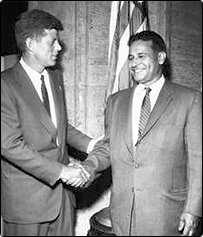|
Dalip Singh Saund
In 1899, Dalip Singh Saund was born in a village in Punjab
Province, India. In 1956, after immigrating to California,
he became the first Asian American elected to the United States
Congress.
Mr. Dalip Saund received his bachelor's degree from the University
of Punjab in 1919. He came to the United States in 1920 to
attend the University of California at Berkeley, and graduated
in 1924 with a master's degree and a doctorate in mathematics.

 
Rep. Saund with President Kennedy
He entered the society of the early '20s — a time when
anti-immigrant bills were pouring out of state and federal
legislatures at a furious pace. In 1921, Warren G. Harding
signed the Quota Immigration Act and the next year signed
the Cable Act, which revoked citizenship for American women
who married foreigners. Saund's American wife lost her citizenship
by marrying him.
Justice Sutherland, speaking for the Supreme Court in 1923,
said that Bhagat Singh Thind and other Asian Indians were
"aliens ineligible to citizenship" because, while
designated as "Caucasian," they were not "white."
Only whites and blacks, in fact, could become citizens —
even though Asian Indians were first recorded in American
records in 1790. By 1900, 2,050 people of East Indian descent
were reported to be living in the United States.
On Sept. 4, 1907 in Bellingham, Wash., violence broke out
among Indian loggers, many of whom fled to Canada or California.
Members of the City Council maintained that the "Hindus"
(although they were Sikhs) brought the action upon themselves
because of their conspicuous clothes (including a turban for
their long hair) and beards. Fighting such anti-Indian prejudice
became key for Saund, who addressed the conflict in his 1930
book, My Mother India.


Congressman Saund with his family
By 1923, the number of Asian Indians in the United States
had grown to some 7,000, but possibilities for citizenship
and the American Dream seemed dim. Had he been born 50 or
60 years later, this enterprising man might have gotten a
teaching position at a prestigious school or joined the growing
legions of Asian Americans in the Silicon Valley. Instead,
like many others from the Punjab region of India, he become
a lettuce farmer and then a distributor of chemical fertilizer
in California's Imperial Valley from 1930 to 1953.
In 1940, Saund formed the Indian Association of America to
help amend American immigration laws to make Asian Indians
eligible for citizenship. His efforts, along with those of
J.J. Singh's Indian League of America and Mubarak Ali Khan's
India Welfare League, paid off when President Harry S. Truman
signed the Luce-Cellar Act in 1946, which permitted citizenship
to Asian Indians but not necessarily others. Until 1946, Saund
was affected by these laws in several ways. His citizen wife
was forced to lose her American citizenship by marrying him,
he was not allowed to become a citizen until 1949, and his
choice of professions was very much limited.
By 1947, Mahatma Gandhi and the people of South Asia had
thrown off the cloak of British colonialism, and many students
of Indian origin started coming to this country to study (although
they were not allowed to become permanent residents until
after 1965). After becoming a citizen in 1949, Saund became
active in mainstream organizations such as the Democratic
Party and the March of Dimes. He was selected as a delegate
to the Democratic National Convention in 1952, 1956 and 1960.
In 1950, he ran for a judgeship in Westmoreland and won —
only to be told that he could not serve because he had not
been a citizen for a full year before the election. Rather
than quitting, he ran again in 1952, and served from then
until he moved to Washington as a congressman in 1957. He
served three terms representing the Imperial Valley. Early
in his campaign for a fourth term, he suffered a stroke and
was defeated in November
Dr. Saund helped to break down the entrenched opposition
to citizenship rights for immigrants of Asian ancestry. He
also was prophetic in warning about lending foreign aid money
solely to central governments. He believed that it would lead
to corrupt practices. He successfully championed the Saund
Amendment to the Foreign Assistance Act of 1961 over the objections
of the Kennedy Admninistration.
To most Asian Indians, however, Saund's main accomplishment
is the pride he gave future generations of politicos and activists.
A century after his birth and a quarter-century after his
death, Dr. Saund continues to inspire Asian Indian advocates.
Nasim G. Memon of the Indian American Forum for Political
Education still remembers Saund's immortal quote: "There
is no room in the United States of America for second-class
citizenship."
Given his impressive achievement of being elected from a
district with almost no Asian Americans in the segregation
era, why isn't Saund better known? Perhaps the lack of knowledge
reflects the greater lack of awareness of Asian American pioneers
and history in general. Under the "Asian American"
rubric, South Asians are further marginalized and made invisible
both due to their low numbers and their racial difference
from what is generally considered to be "Asian,"
said Aly Kassam-Remtulla, Rhodes Scholar and former Instructor
in Asian American Studies at Stanford University. Another
theory, posited by Dr. Rajini Srikanth of the University of
Massachusetts at Boston, is that Saund's invisibility stems
from the tone of his book Congressman from India — a
"very upbeat, very gung-ho" tone about the United
States, and very celebratory of individual effort and resolve.
Given that Asian American studies has by and large seen itself
as a protest movement, as a challenge to established systems,
Saund's optimism may come across as inappropriate and the
lack of anger he professed as misguided.
Asian Indians Today
In any case, Saund today would be proud to see that distinguished
Americans of South Asian ancestry include conductor Zubin
Mehta, former EEOC Commissioner Joy Cherian, award-winning
author Bharati Mukherjee, and filmmaker Ismail Merchant. According
to government estimates, there were 359,000 Asian Indian Americans
in 1980, 815,447 in 1990 and more than 1.3 million today,
including some 25,000 medical doctors. By 1990 Census estimates,
Asian Indians had a per capita income of $17,777 as compared
with the national average of $14,420, and high levels of educational
achievement (averaging 15.6 years) and annual household income
($34,300).
Though no Asian Indian has yet matched Saund's success, Asian
Indians have served on the state level in Maryland, Minnesota,
and Wyoming, and run for office in states as diverse as California,
New York, South Dakota, and Georgia.
Dalip Singh Saund died on April 22, 1973, in Hollywood, Calif.,
and was interred in Forest Lawn Cemetery in Glendale, Calif.
Said Don Nakanishi, head of UCLA's Asian American Studies
Center: "On his 100th birthday, I hope we shine a bright
light on his political career and the lessons we can learn
from his remarkable achievements."
|







